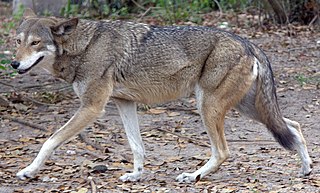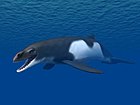
The Atlantic Ocean is the second-largest of the world's oceans, with an area of about 106,460,000 km2 (41,100,000 sq mi). It covers approximately 20 percent of Earth's surface and about 29 percent of its water surface area. It is known to separate the "Old World" from the "New World" in the European perception of the World.

The brown bear is a large bear species found across Eurasia and North America. In North America, the populations of brown bears are called grizzly bears, while the subspecies that inhabits the Kodiak Islands of Alaska is known as the Kodiak bear. It is one of the largest living terrestrial members of the order Carnivora, rivaled in size only by its closest relative, the polar bear, which is much less variable in size and slightly bigger on average. The brown bear's range includes parts of Russia, Central Asia, China, Canada, the United States, Hokkaido, Scandinavia, Finland, the Balkans, the Picos de Europa and the Carpathian region, Iran, Anatolia, and the Caucasus. The brown bear is recognized as a national and state animal in several European countries.

The blue whale is a marine mammal belonging to the baleen whale parvorder Mysticeti. Reaching a maximum confirmed length of 29.9 metres (98 ft) and weighing up to 199 tonnes, it is the largest animal known to have ever existed. The blue whale's long and slender body can be various shades of greyish-blue dorsally and somewhat lighter underneath.

The coyote is a species of canine native to North America. It is smaller than its close relative, the wolf, and slightly smaller than the closely related eastern wolf and red wolf. It fills much of the same ecological niche as the golden jackal does in Eurasia. The coyote is larger and more predatory and was once referred to as the American jackal by a behavioral ecologist. Other historical names for the species include the prairie wolf and the brush wolf.

There are 38 subspecies of Canis lupus listed in the taxonomic authority Mammal Species of the World. These subspecies were named over the past 250 years, and since their naming, a number of them have gone extinct. The nominate subspecies is the Eurasian wolf.

Felidae is a family of mammals in the order Carnivora, colloquially referred to as cats, and constitutes a clade. A member of this family is also called a felid. The term "cat" refers both to felids in general and specifically to the domestic cat.

The jaguar is a large felid species and the only living member of the genus Panthera native to the Americas. With a body length of up to 1.85 m and weight of up to 96 kg (212 lb), it is the largest cat species in the Americas and the third largest in the world. Its distinctively marked coat features pale yellow to tan colored fur covered by spots that transition to rosettes on the sides. The jaguar's powerful bite allows it to pierce the carapaces of turtles and tortoises, and to employ an unusual killing method: it bites directly through the skull of mammalian prey between the ears to deliver a fatal blow to the brain.

A mammoth is any species of the extinct elephantid genus Mammuthus, one of the many genera that make up the order of trunked mammals called proboscideans. The various species of mammoth were commonly equipped with long, curved tusks and, in northern species, a covering of long hair. They lived from the Pliocene epoch into the Holocene at about 4,000 years ago, and various species existed in Africa, Europe, Asia, and North America. They were members of the family Elephantidae, which also contains the two genera of modern elephants and their ancestors. Mammoths are more closely related to living Asian elephants than African Elephants.

The Paleogene is a geologic period and system that spans 43 million years from the end of the Cretaceous Period 66 million years ago (Mya) to the beginning of the Neogene Period 23.03 Mya. It is the beginning of the Cenozoic Era of the present Phanerozoic Eon. The earlier term Tertiary Period was used to define the span of time now covered by the Paleogene and subsequent Neogene Periods; despite no longer being recognised as a formal stratigraphic term, 'Tertiary' is still widely found in earth science literature and remains in informal use. The Paleogene is most notable for being the time during which mammals diversified from relatively small, simple forms into a large group of diverse animals in the wake of the Cretaceous–Paleogene extinction event that ended the preceding Cretaceous Period. The United States Geological Survey uses the abbreviation PE for the Paleogene, but the more commonly used abbreviation is PG with PE being used for Paleocene, an epoch within the Paleogene.

The red wolf is a canine native to the southeastern United States. Morphologically it is intermediate between the coyote and gray wolf, and is very closely related to the eastern wolf of eastern Canada.

Porcupines are large rodents with coats of sharp spines, or quills, that protect them against predation. The term covers two families of animals: the Old World porcupines of family Hystricidae, and the New World porcupines of family Erethizontidae. Both families belong to the infraorder Hystricognathi within the profoundly diverse order Rodentia and display superficially similar coats of rigid and/or semi-rigid quills which are modified hairs composed of keratin. Despite this, the two groups are distinct from one another and are not closely related to each other within the Hystricognathi. The largest species of porcupine is the third-largest living rodent in the world after the capybara and beaver.

The cougar is a large cat of the subfamily Felinae. Native to the Americas, its range spans from the Canadian Yukon to the southern Andes in South America and is the most widespread of any large wild terrestrial mammal in the Western Hemisphere. It is an adaptable, generalist species, occurring in most American habitat types. Due to its wide range, it has many names, including puma, mountain lion, catamount, panther and painter.

The bobcat, also known as the red lynx, is a medium-sized cat native to North America. It ranges from southern Canada through most of the contiguous United States to Oaxaca in Mexico. It is listed as Least Concern on the IUCN Red List since 2002, due to its wide distribution and large population. Although it has been hunted extensively both for sport and fur, populations have proven stable, though declining in some areas.

A mastodon is any proboscidean belonging to the extinct genus Mammut that inhabited North and Central America during the late Miocene or late Pliocene up to their extinction at the end of the Pleistocene 10,000 to 11,000 years ago. Mastodons lived in herds and were predominantly forest-dwelling animals that lived on a mixed diet obtained by browsing and grazing, somewhat similar to their distant relatives, modern elephants, but probably with greater emphasis on browsing.

Cardinals, in the family Cardinalidae, are passerine birds found in North and South America, Central America, and the Caribbean. They are also known as cardinal-grosbeaks and cardinal-buntings.

The American Legion, commonly known as the Legion, is a nonprofit organization of U.S. war veterans headquartered in Indianapolis, Indiana. It is made up of state, U.S. territory, and overseas departments, and these are in turn made up of local posts. The organization was formed on March 15, 1919, in Paris, France, by a thousand officers and men of the American Expeditionary Forces, and it was chartered on September 16, 1919, by the United States Congress. The Legion played the leading role in the drafting and passing of the Servicemen's Readjustment Act of 1944, commonly known as the "G.I. Bill". In addition to organizing commemorative events, members provide assistance at Department of Veterans Affairs (VA) hospitals and clinics. It is active in issue-oriented U.S. politics. Its primary political activity is lobbying on behalf of interests of veterans and service members, including support for benefits such as pensions and the Veterans Health Administration. It has also historically promoted Americanism, individual obligation to the community, state, and nation; peace and good will.

The Clovis culture is a prehistoric Paleoamerican culture, named for distinct stone tools found in close association with Pleistocene fauna at Blackwater Locality No. 1 near Clovis, New Mexico, in the 1920s and 1930s. It appears around 11,500–11,000 uncalibrated RCYBP at the end of the last glacial period and is characterized by the manufacture of "Clovis points" and distinctive bone and ivory tools. Archaeologists' most precise determinations at present suggest this radiocarbon age is equal to roughly 13,200 to 12,900 calendar years ago. Clovis people are considered to be the ancestors of most of the indigenous peoples of the Americas.

The North American Aviation T-6 Texan is an American single-engined advanced trainer aircraft used to train pilots of the United States Army Air Forces (USAAF), United States Navy, Royal Air Force, Royal Canadian Air Force and other air forces of the British Commonwealth during World War II and into the 1970s. Designed by North American Aviation, the T-6 is known by a variety of designations depending on the model and operating air force. The United States Army Air Corps (USAAC) and USAAF designated it as the AT-6, the United States Navy the SNJ, and British Commonwealth air forces the Harvard, the name by which it is best known outside the US. Starting in 1948, the new United States Air Force (USAF) designated it the T-6, with the USN following in 1962. It remains a popular warbird used for airshow demonstrations and static displays. It has also been used many times to simulate various historical aircraft, including the Japanese Mitsubishi A6M Zero. A total of 15,495 T-6s of all variants were built.

Helianthus is a genus comprising about 70 species of annual and perennial flowering plants in the daisy family Asteraceae. Except for three South American species, the species of Helianthus are native to North America and Central America. The common names "sunflower" and "common sunflower" typically refer to the popular annual species Helianthus annuus, whose round flower heads in combination with the ligules look like the sun. This and other species, notably Jerusalem artichoke, are cultivated in temperate regions and some tropical regions as food crops for humans, cattle, and poultry, and as ornamental plants. The species H. annuus typically grows during the summer and into early fall, with the peak growth season being mid-summer.

L'Anse aux Meadows is an archaeological site of a Norse settlement dating to c. 1000 on the northernmost tip of the island of Newfoundland in the Canadian province of Newfoundland and Labrador. Archaeological evidence of a Norse presence was discovered at L'Anse aux Meadows in the 1960s. It is the only confirmed Norse site in or near North America outside of the settlements found in Greenland.























